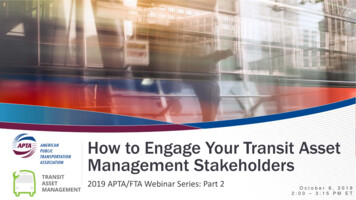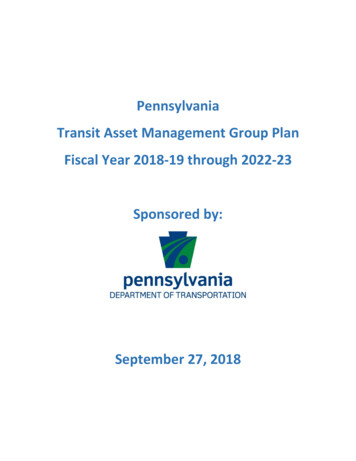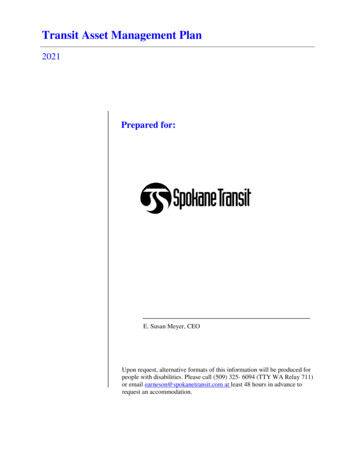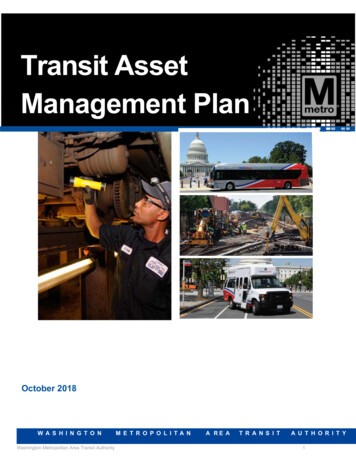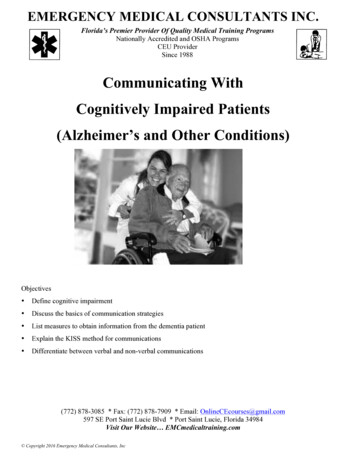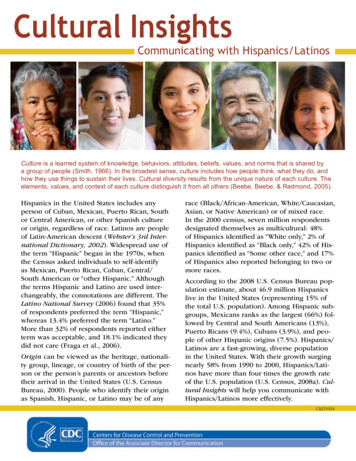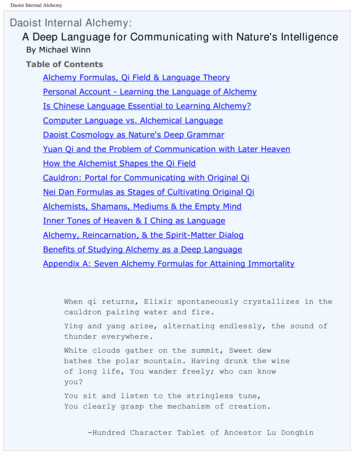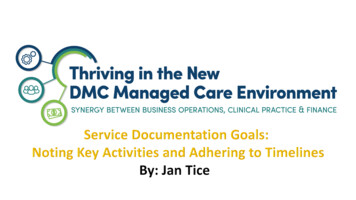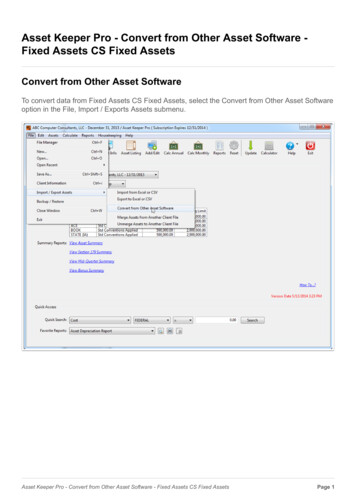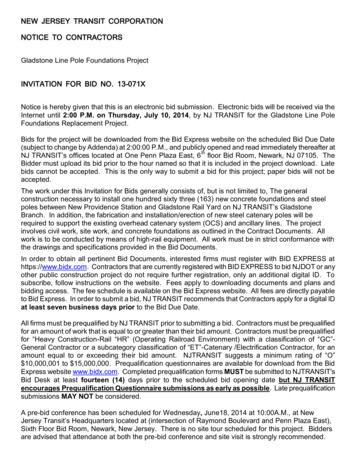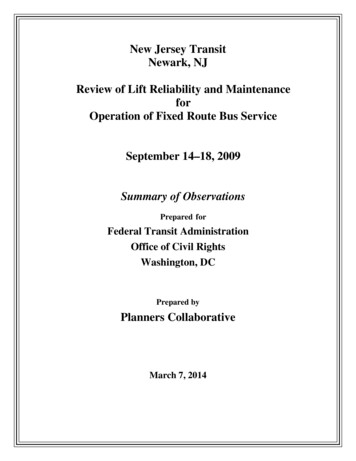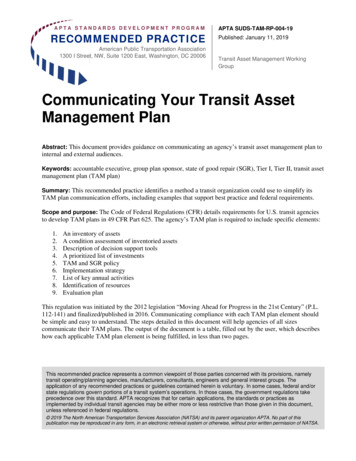
Transcription
APTA STANDARDS DEVELOPMENT PROGRAMRECOMMENDED PRACTICEAmerican Public Transportation Association1300 I Street, NW, Suite 1200 East, Washington, DC 20006APTA SUDS-TAM-RP-004-19Published: January 11, 2019Transit Asset Management WorkingGroupCommunicating Your Transit AssetManagement PlanAbstract: This document provides guidance on communicating an agency’s transit asset management plan tointernal and external audiences.Keywords: accountable executive, group plan sponsor, state of good repair (SGR), Tier I, Tier II, transit assetmanagement plan (TAM plan)Summary: This recommended practice identifies a method a transit organization could use to simplify itsTAM plan communication efforts, including examples that support best practice and federal requirements.Scope and purpose: The Code of Federal Regulations (CFR) details requirements for U.S. transit agenciesto develop TAM plans in 49 CFR Part 625. The agency’s TAM plan is required to include specific elements:1.2.3.4.5.6.7.8.9.An inventory of assetsA condition assessment of inventoried assetsDescription of decision support toolsA prioritized list of investmentsTAM and SGR policyImplementation strategyList of key annual activitiesIdentification of resourcesEvaluation planThis regulation was initiated by the 2012 legislation “Moving Ahead for Progress in the 21st Century” (P.L.112-141) and finalized/published in 2016. Communicating compliance with each TAM plan element shouldbe simple and easy to understand. The steps detailed in this document will help agencies of all sizescommunicate their TAM plans. The output of the document is a table, filled out by the user, which describeshow each applicable TAM plan element is being fulfilled, in less than two pages.This recommended practice represents a common viewpoint of those parties concerned with its provisions, namelytransit operating/planning agencies, manufacturers, consultants, engineers and general interest groups. Theapplication of any recommended practices or guidelines contained herein is voluntary. In some cases, federal and/orstate regulations govern portions of a transit system’s operations. In those cases, the government regulations takeprecedence over this standard. APTA recognizes that for certain applications, the standards or practices asimplemented by individual transit agencies may be either more or less restrictive than those given in this document,unless referenced in federal regulations. 2019 The North American Transportation Services Association (NATSA) and its parent organization APTA. No part of thispublication may be reproduced in any form, in an electronic retrieval system or otherwise, without prior written permission of NATSA.
Table of ContentsParticipants. iiiIntroduction . iii1. Procedure . 12. Intended use and benefits . 1Abbreviations and acronyms. 3Document history . 3Appendix A: Examples . 4Appendix B: Templates . 14List of Figures and TablesTable 1 Tier 1 Example . 4Table 2 Tier 1 Example with Links . 6Table 3 Tier 2 Example . 8Table 3 Tier 2 Example with Links . 9Table 5 Group TAM Plan Example. 10Table 6 Group TAM Plan Example with Links . 12Table 7 Tier 1 Template . 14Table 8 Tier 1 Template with Links . 15Table 9 Tier 2 Template . 16Table 10 Tier 2 Template with Links . 17Table 11 Group TAM Plan Template . 18Table 12 Group TAM Plan Template with Links. 19 2019 American Public Transportation Association ii
ParticipantsThe American Public Transportation Association greatly appreciates the contributions of the Transit AssetManagement Working Group, which provided the primary effort in the drafting of this document.At the time this standard was completed, the working group included the following members:Laura Zale, SEPTA, ChairPaul Edwards, Utah Transit AuthorityRobert Peskin, AECOMTeresa Ray, MARTAJustin Barclay, MDOT Maryland TransitAdministrationTina Ignat, MetraTodd Lang, Baltimore Metropolitan CouncilJohn McCormick, BARTSharon Okoye, Connecticut DOTVictor Rivas, JacobsDavid Rose, Gannett FlemingMshadoni Smith, Federal Transit AdministrationSimon Smith, AMCLDebbie Swickard, Stark Area RTALuke Westlund, Regional Transportation DistrictMatthew Wilson, JTAProject teamElizabeth Lovinggood, American Public Transportation AssociationIntroductionThis introduction is not part of APTA SUDS-TAM-RP-004-19, “Communicating Your Transit AssetManagement Plan.”APTA recommends the use of this document by: individuals or organizations that operate rail transit systems;individuals or organizations that contract with others for the operation of rail transit systems; andindividuals or organizations that influence how rail transit systems are operated (including but notlimited to consultants, designers and contractors).This document makes the following assumptions: The reader understands the difference between Tier I, Tier II and a group TAM plan sponsor.The reader understands the nine TAM plan requirements and applicability to his or her agency.The reader understands the applicable NTD reporting requirements.The agency’s TAM plan has been self-certified and signed by the accountable executive. 2019 American Public Transportation Association iii
APTA SUDS-TAM-RP-004-19Communicating Your Transit Asset Management PlanCommunicating Your Transit Asset ManagementPlan1. Procedure1. To better understand the end product, users should read the examples that apply to their agencies,provided in Appendix A. All information is editable and intended to be used as an example only;users should feel free to customize any part.NOTE: Keep in mind that the examples listed in Appendix A are intended to be concise. All examples,regardless of an agency’s classification, are less than two pages in length.a. Appendix A: Examplesi. Tier 1ii. Tier 2iii. Group TAM plan2. Users should next decide if they would like to provide links to their agency’s internal documents. Theprimary benefit of linking to corresponding documents is to provide an additional layer of credibilityand to show alignment with other agency documents, indicating further asset management maturity.a. Appendix A: Examplesi. Tier 1 with linksii. Tier 2 with linksiii. Group TAM plan with links3. Users should then choose the correct template based on individual needs.a. Appendix B: Templatesi. Tier 1ii. Tier 1 with linksiii. Tier 2iv. Tier 2 with linksv. Group TAM planvi. Group TAM plan with links4. Users should then fill out the template with their agency’s information, using the examples inAppendix A as the guidepost. Each table contains a question or statement for each TAM plan elementintended to help the user keep the explanation at a high level.2. Intended use and benefitsThe initial October 2018 deadline provides an immediate opportunity to communicate a TAM plan to internaland external audiences. The FTA highlights active communication as one of the steps to create a TAM culturewithin transit organizations. The FTA also highlights the importance of having a process in place to sharerequired TAM information, including TAM plans and targets, with a metropolitan planning organization(MPO) and/or state DOT planning partners. 2019 American Public Transportation Association1
APTA SUDS-TAM-RP-004-19Communicating Your Transit Asset Management PlanAn individual familiar with his or her agency and MAP-21 should be able to use this tool to communicate therequired elements of the TAM plan in less than five minutes and under two pages. This will make the TAMplan relevant to a broader audience.Moving past the October 2018 deadline, the completed table (with linked documents) can act as a “table ofcontents” to an agency’s transit asset management system. The table can be viewed as a living document andupdated as the agency’s TAM plan is revised, or as the agency’s asset management system matures. 2019 American Public Transportation Association2
APTA SUDS-TAM-RP-004-19Communicating Your Transit Asset Management PlanAbbreviations and acronymsCFRDOTLMPMAP-21MPONATSANTDSGRTAMxxCode of Federal RegulationsDepartment of Transportationlifecycle management planMoving Ahead for Progress in the 21st Centurymetropolitan planning organizationNorth American Transportation Services AssociationNational Transit Databasestate of good repairtransit asset managementxxDocument historyDocumentVersionWorking GroupVotePublic Comment/TechnicalOversightCEO ApprovalPolicy &PlanningApprovalPublish DateFirst publishedSept. 9, 2018Oct. 30, 2018Nov.19, 2018Jan. 4, 2019Jan. 11, 2019 2019 American Public Transportation Association3
APTA SUDS-TAM-RP-004-19Communicating Your Transit Asset Management PlanAppendix A: ExamplesTier 1TABLE 1Tier 1 Example1. INVENTORYRevenue vehicles1655 revenue vehicles: 794 buses 477 vans 338 rail cars 46 locomotivesInfrastructure1,510,396 linear feet of track: Light rail: 348,480 linear feet Metro: 158,400 linear feet Commuter rail: 15,840 linear feet of owned track Freight rail: 987,676 linear feetFacilities204 facilities: Administrative: 17 General maintenance: 26 Heavy maintenance: 1 Bus loop: 4 Parking lot: 24 Parking site: 54 Parking site (garage): 3 Parking passenger station: 1 Passenger station: 74Equipment315 nonrevenue vehicles: 99 cars 190 trucks 3 vans 23 equipment vehicles2. CONDITION ASSESSMENTRevenue vehiclesAge-based analysisInfrastructureGuideway under performance restrictionFacilitiesThe agency is currently utilizing age-based condition assessment. In CY 2018assessing (physical condition) 25 percent of facilities over the course of a fouryear period per NTD requirements.EquipmentAge-based analysis3. DECISION SUPPORT TOOLSWhat tools and processes do we useto prioritize funding around thoseassets described in our inventory?The agency utilizes TERM Lite as a decision support tool to estimate capitalinvestment needs over a four-year period, as well as 20- to 30-year projectionsfor long range planning, and estimate SGR backlog.4. PRIORITIZED LIST OF INVESTMENTSWhat is the result or output of thosedecision support tools andprocesses?The agency prioritizes its assets based on weighting criteria established inTERM Lite with emphasis on SGR and Safety (resulting from input by assetmanagers across all modes). TERM Lite weighting criteria are being utilized toorganize capital project requests based on SGR needs. 2019 American Public Transportation Association4
APTA SUDS-TAM-RP-004-19Communicating Your Transit Asset Management PlanTABLE 1Tier 1 Example5. TAM AND SGR POLICYWhat are the guiding principles forasset management efforts at ouragency?The agency established a directive, aligning with the state DOT TAM policy, aswell as a TAM plan, satisfying all federal requirements. Initiation ofimprovement projects aimed at accelerating the maturation of the agency’sasset management program.6. IMPLEMENTATION STRATEGYHow are we going to execute theTAM plan at our agency?The TAM plan includes an implementation strategy, as well as the detailed listof 48 improvement projects (activities) that will be completed over the four- tosix-year TAM horizon.7. LIST OF KEY ANNUAL ACTIVITIESWhat activities do we perform tomaintain our TAM system?The agency performs the following annual activities: updates inventory,performs facility assessments at a rate of 25 percent per year, updates theasset performance measurement analysis, revises the TAM plan, lifecyclemanagement plans (LMPs) for all modes to reflect new data analysis, updatesperformance targets, and fulfills NTD reporting requirements.8. IDENTIFICATION OF RESOURCESWhat resources do we need toexecute TAM plan activities at ouragency?The agency includes a detailed list of funding sources, a list of assetmanagement personnel and key support staff with total expense cost, andcosts of maintaining assets in a state of good repair in the TAM plan document.9. EVALUATION PLANWhat is the agency doing to ensurethat the TAM plan delivers theintended results?The asset management program manager/coordinator leads all efforts inachieving asset management tasks and requirements for the agency,coordinating with internal and consultant support. Among those efforts: Leading the reporting of NTD requirements Updating of TAM plan and LMPs for all operating modes Completing improvement projects in the TAM plan Leading facility assessments Coordinating with capital programming for the call for projects to securean SGR prioritized list of projects through the investment prioritization tool Supporting Tier 2 asset management efforts Completing inventory update and TERM Lite Analysis 2019 American Public Transportation Association5
APTA SUDS-TAM-RP-004-19Communicating Your Transit Asset Management PlanTier 1 with linksTABLE 2Tier 1 Example with Links1. INVENTORYCorresponding DocumentsRevenue vehicles1655 revenue vehicles: 794 buses 477 vans 338 rail cars 46 locomotives Inventory—RevenueVehiclesInfrastructure1,510,396 linear feet of track: Light rail: 348,480 linear feet Metro: 158,400 linear feet Commuter rail: 15,840 linear feet of owned track Freight rail: 987,676 linear feet Inventory—InfrastructureFacilities204 facilities: Administrative: 17 General maintenance: 26 Heavy maintenance: 1 Bus loop: 4 Parking lot: 24 Parking site: 54 Parking site (garage): 3 Parking passenger station: 1 Passenger station: 74 Inventory—FacilitiesEquipment315 nonrevenue vehicles: 99 cars 190 trucks 3 vans 23 equipment vehicles Inventory—Equipment2. CONDITION ASSESSMENTCorresponding DocumentsRevenue vehicles Useful Life Benchmarks(ULB)Age-based analysisInfrastructureGuideway under performance restrictionFacilitiesEquipmentThe agency is currently utilizing age-based conditionassessment. In CY 2018 assessing (physical condition) 25percent of facilities over the course of a four-year period perNTD requirements.Age-based analysis Guideway UnderPerformance RestrictionProcedure Facilities ConditionAssessment Useful Life Benchmarks(ULB)3. DECISION SUPPORT TOOLSCorresponding DocumentsWhat tools andprocesses do we useto prioritize fundingaround those assetsdescribed in ourinventory? TERM Lite—Long RangePlanning Asset Information Strategy Investment PrioritizationPolicyThe agency utilizes TERM Lite as a decision support tool toestimate capital investment needs over a four-year period, aswell as 20- to 30-year projections for long range planning,and estimate SGR backlog. 2019 American Public Transportation Association6
APTA SUDS-TAM-RP-004-19Communicating Your Transit Asset Management PlanTABLE 2Tier 1 Example with Links4. PRIORITIZED LIST OF INVESTMENTSCorresponding DocumentsWhat is the result oroutput of thosedecision support toolsand processes? Approved Capital Projects2018-2022The agency prioritizes its assets based on weighting criteriaestablished in TERM Lite with emphasis on SGR and Safety(resulting from input by asset managers across all modes).TERM Lite weighting criteria are being utilized to organizecapital project requests based on SGR needs.5. TAM AND SGR POLICYCorresponding DocumentsWhat are the guidingprinciples for assetmanagement effortsat our agency? Asset Management PolicyThe agency established a directive, aligning with the stateDOT TAM policy, as well as a TAM plan, satisfying all federalrequirements. Initiation of improvement projects aimed ataccelerating the maturation of the agency’s assetmanagement program.6. IMPLEMENTATION STRATEGYCorresponding DocumentsHow are we going toexecute the TAM planat our agency? Asset ManagementRoadmapThe TAM plan includes an implementation strategy, as wellas the detailed list of 48 improvement projects (activities) thatwill be completed over the four- to six-year TAM horizon.7. LIST OF KEY ANNUAL ACTIVITIESCorresponding DocumentsWhat activities do weperform to maintainour TAM system? Annual Review Procedure Annual Review ChecklistThe agency performs the following annual activities: updatesinventory, performs facility assessments at a rate of 25percent per year, updates the asset performancemeasurement analysis, revises the TAM plan, lifecyclemanagement plans (LMPs) for all modes to reflect new dataanalysis, updates performance targets, and fulfills NTDreporting requirements.8. IDENTIFICATION OF RESOURCESCorresponding DocumentsWhat resources dowe need to executeTAM plan activities atour agency? Organizational Chart Annual BudgetThe agency includes a detailed list of funding sources, a listof asset management personnel and key support staff withtotal expense cost, and costs of maintaining assets in a stateof good repair in the TAM plan document.9. EVALUATION PLANWhat is the agencydoing to ensure thatthe TAM plan deliversthe intended results?Corresponding DocumentsThe asset management program manager/coordinator leadsall efforts in achieving asset management tasks andrequirements for the agency, coordinating with internal andconsultant support. Among those efforts: Leading the reporting of NTD requirements Updating of TAM plan and LMPs for all operatingmodes Completing improvement projects in the TAM plan Leading facility assessments Coordinating with capital programming for the call forprojects to secure an SGR prioritized list of projectsthrough the investment prioritization tool Supporting Tier 2 asset management efforts Completing inventory update and TERM Lite Analysis 2019 American Public Transportation Association Annual Review Procedure Annual Review Checklist7
APTA SUDS-TAM-RP-004-19Communicating Your Transit Asset Management PlanTier 2TABLE 3Tier 2 Example1. INVENTORYRevenue vehicles47 revenue vehicles: 1 car 1 van 45 busesFacilities3 facilities total: Administrative/operational building Maintenance building Bus washEquipmentEquipment valued at 15,000 or higher: 5 ITS systems Miscellaneous equipment2. CONDITION ASSESSMENTRevenue vehiclesAge-based analysis or mileageFacilitiesThe agency currently utilizes age-based condition assessment. In CY 2018assessing (physical condition) 25 percent of facilities over the course of a fouryear period per NTD requirements.EquipmentAge-based analysis3. DECISION SUPPORT TOOLSWhat tools and processes do we useto prioritize funding
contents” to an agency’s t ransit asset management system. The table can be viewed as a living docum
